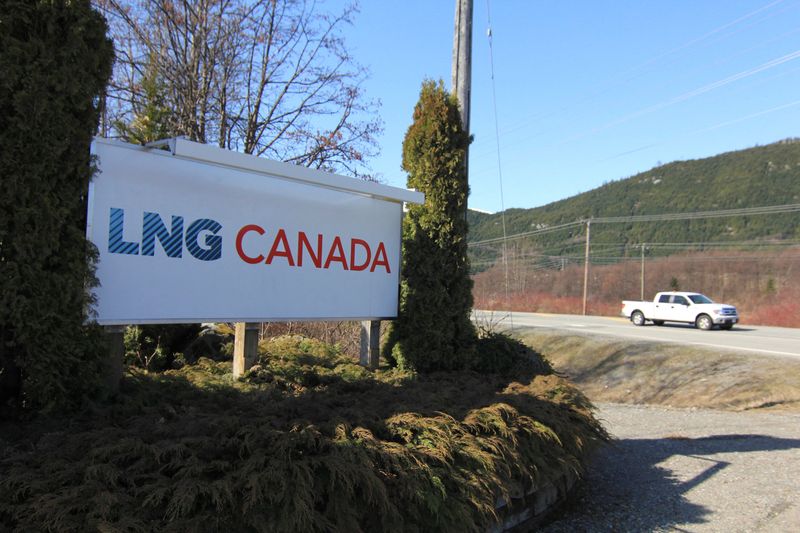Canada’s B.C. province sets high emissions bar for new LNG projects
2023.03.17 06:45
2/2

© Reuters. FILE PHOTO: The entrance to Shell’s LNG Canada project site is shown in Kitimat in northwestern British Columbia on April 12, 2014. REUTERS/Julie Gordon/File Photo
2/2
By Nia Williams
(Reuters) – British Columbia’s decision this week to toughen emissions standards for new liquefied (LNG) projects creates one of the most robust climate plans in North America, but sets a high hurdle for industry even as many countries look to Canada to become a global supplier of gas.
As part of a new energy action framework, the western Canadian province will require proposed LNG projects that are going through or entering the environmental assessment process to have a credible plan to be net-zero emissions by 2030.
While the tougher regulation will not impact the huge Shell-led LNG Canada project already under construction, a proposed export terminal adjoining the small-scale Tilbury LNG facility and the early-stage Ksi Lisims LNG project in northern B.C will fall under the new rule.
Canada is the world’s sixth-largest gas producer and its west coast LNG industry has seen revived interest as the world tries to secure alternatives to Russian gas supply following the invasion of Ukraine.
The province will start exporting 14 million tonnes per annum (MTPA) when LNG Canada enters service in 2025.
“That (net-zero requirement) is a very high bar and a high hurdle to pass,” said Mark Zacharias, executive director of think-tank Clean Energy Canada, adding the new framework rounds out B.C.’s plan to cut emissions 40% below 2005 levels by 2030.
“The B.C. roadmap to 2030 is probably North America’s strongest climate plan but what was missing until now was answers on dealing with oil and gas. This fills in the missing gaps.”
Ksi Lisims, proposed as a 12-MTPA plant, will achieve net-zero through a fully electrified facility that utilizes renewable hydro power and carbon offsetting, spokesperson Rebecca Scott said.
FortisBC, one of the companies behind the Tilbury Marine Jetty project, said it welcomed the clarity the framework provides for LNG development and “looked forward to engaging with government” on the 2030 guidelines.
B.C. released its energy action framework alongside a positive environmental assessment for the C$3-billion ($2.2 billion) Cedar LNG project, a joint venture between Haisla First Nation and Pembina Pipeline (NYSE:) Corp.
The province said it will sign an agreement with the Haisla Nation to explore ways to lower emissions to near zero by 2030.
OIL AND GAS CAP
B.C.’s new regulations also include an oil and gas emissions cap and plans to accelerate the electrification of the economy.
Tristan Goodman, CEO of the Explorers and Producers Association of Canada, said the framework is generally “constructive and positive”, but the industry had some concerns about how the cap would be implemented.
“The message from the province is ‘We believe we can develop natural gas and move forward broadly on Indigenous reconciliation while also meeting out climate ambitions’,” Goodman said. “That’s good, but the concern lies in the details.”
TC Energy (NYSE:), which is building the Coastal GasLink pipeline that will supply LNG Canada and Cedar LNG, said in a statement on Wednesday it was “carefully reviewing” the framework.
Prime Minister Justin Trudeau’s Liberal government is targeting a 40-45% cut in emissions by 2030, and has also promised an emissions cap for the oil and gas industry, Canada’s highest-polluting sector.
Canadian Natural (NYSE:) Resources Minister Jonathan Wilkinson praised the new provincial regulations.
“By committing to capping emissions from the oil and gas sector in the province, B.C. is setting the pace for bold environmental action,” he said.








